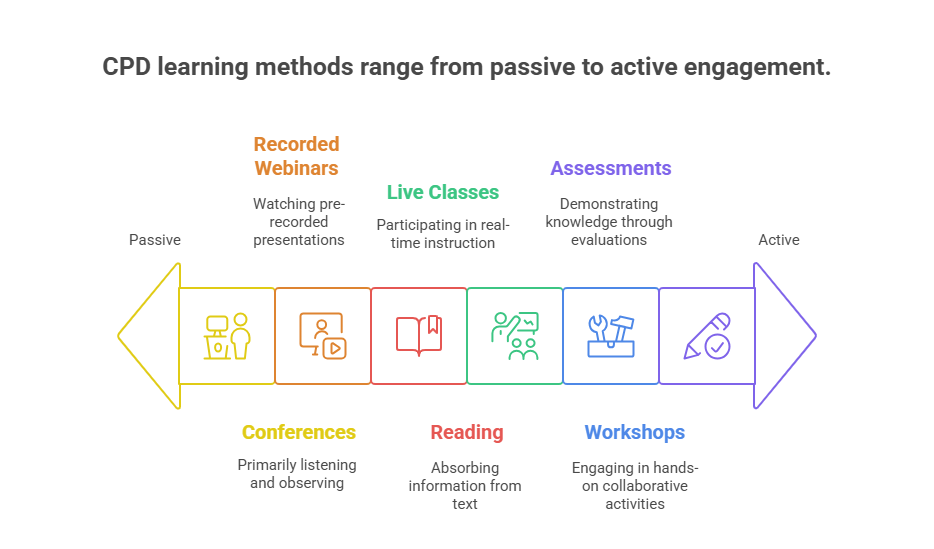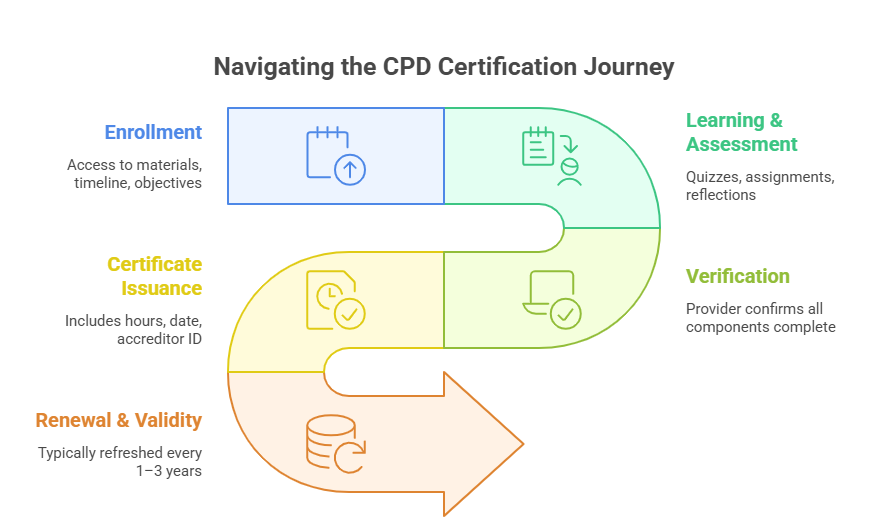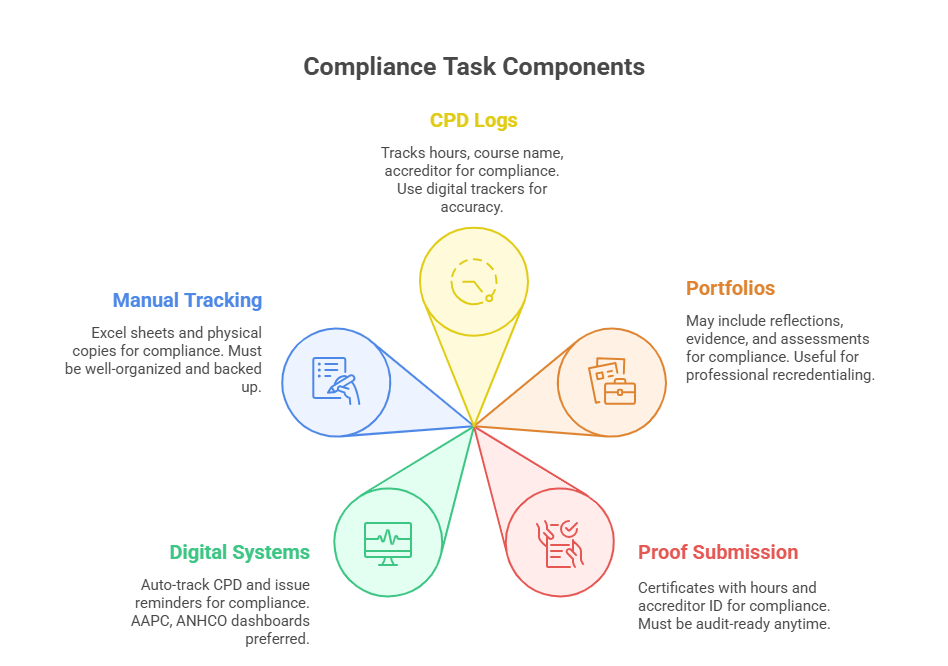Understanding CPD Points and Certification Process
Continuing Professional Development (CPD) is the global standard for maintaining professional excellence. Whether you're in coaching, healthcare, finance, or project management, CPD ensures your skills stay current, credible, and competitive. These structured learning activities go beyond traditional education and reflect real-world competency, whether through certified courses, hands-on workshops, or structured webinars. In regulated professions, CPD is not just a preference — it’s often a requirement for continued licensing, promotion, and credibility.
From the UK’s CPD Standards Office to the AAPC in the U.S., global regulators use CPD to measure learning in hours, credits, or units. CPD-certified programs undergo thorough evaluation for content quality, learner outcomes, and industry relevance. The result? Professionals and employers alike can trust that what’s learned is practical, up-to-date, and applicable. For coaches, enrolling in a CPD-certified course can mean greater client trust, expanded opportunities, and alignment with international standards. This guide breaks down the CPD structure, accreditation process, and how to stay fully compliant — with zero fluff.
What Are CPD Points and How Are They Measured?
Continuing Professional Development (CPD) points are units used to quantify time spent on structured, skills-based learning that supports professional growth. These points help employers, licensing bodies, and professionals themselves track how much relevant education has been completed over time. But not all CPD points are created equal — different industries and regions measure them in various formats, making it critical to understand how your CPD activity translates in your field.
Hours vs Units vs Credits
Some CPD systems measure activity in actual learning hours — typically, one CPD point equals one hour of active participation. However, others use credits or units, which may weigh activities differently based on complexity or outcomes. For example, a live webinar may count for more than a passive video because it includes engagement and interaction. In healthcare or legal fields, CPD credit systems are often tiered to distinguish between core and non-core subjects. This is important for meeting strict licensing or renewal criteria in professions like law or medicine.
In most systems:
1 CPD point = 1 hour of learning
10 learning hours = 10 CPD credits or units, depending on region
Workshops and instructor-led training often earn more points than passive learning
This structure ensures consistency in how learning is tracked across CPD-accredited institutions globally.
Passive vs Active Learning Categories
CPD is typically categorized into two types: active and passive learning. Active learning involves direct participation — such as instructor-led courses, interactive workshops, or assessments. Passive learning includes reading articles, watching pre-recorded content, or attending conferences without interaction. While both are valid, most accreditation bodies cap the number of passive CPD points that can count toward annual compliance.
Active learning is generally preferred for certification and professional audits. In fact, many CPD-accredited courses mandate a combination of both formats to fulfill comprehensive development requirements. This ensures learners not only absorb content but demonstrate understanding through practical exercises, reflections, or quizzes.
Common Misconceptions About CPD
A widespread myth is that all learning automatically qualifies for CPD — it doesn’t. To count toward formal CPD compliance, learning activities must be structured, verifiable, and aligned with role-specific competencies. Casual reading or untracked webinars won’t count unless the activity meets the accrediting body’s documentation standards.
Another misconception is that CPD points are always transferable across borders. In reality, CPD systems vary by country and industry, and many employers only recognize points from bodies they trust — such as the CPD Standards Office (UK) or AAPC (US). Verifying whether a course is recognized in your jurisdiction before enrolling is essential for avoiding wasted time and effort.
Finally, professionals often assume CPD is only necessary during licensing years. However, top employers value ongoing evidence of professional learning, especially in roles that evolve with technology or regulation. Keeping CPD points current isn’t just about compliance — it’s a signal of commitment and capability in the eyes of recruiters and clients alike.
CPD Accreditation Bodies Worldwide
The credibility of a CPD certification hinges entirely on who accredits the course. Not all CPD labels carry the same weight — and many employers, licensing agencies, and regulators will only accept credits from bodies that follow transparent, internationally recognized standards. Understanding the major CPD authorities worldwide helps professionals choose programs that actually advance careers and fulfill regulatory obligations.
CPD Standards Office, AAPC, ACCRE, CME
The CPD Standards Office (UK) is one of the most widely respected accreditation bodies, especially in coaching, education, and corporate training. Its framework emphasizes learner outcomes, structured assessments, and clear quality benchmarks. Courses certified by this body are often recognized across Europe, Asia, and the Middle East.
In the United States, the AAPC plays a similar role for healthcare professionals, particularly in medical billing, coding, and administration. Its CPD-style continuing education requirements are structured in units and tied to maintaining certifications such as CPC and CPB.
The Accreditation Council for Clinical Research Education (ACCRE) focuses on CPD in clinical research roles — especially for coordinators, associates, and monitors. Their emphasis is on ethics, GCP, and trial compliance standards. Meanwhile, the Continuing Medical Education (CME) system — often confused with CPD — governs physician and nurse learning but shares many CPD principles, especially around hours and credit-based tracking.
Each of these bodies:
Sets minimum standards for content and instructor qualification
Requires verifiable learning outcomes (exams, reflections, or portfolios)
Ensures learning is industry-specific, up-to-date, and non-promotional
Programs certified by these authorities hold stronger reputational and career value than uncertified or self-claimed CPD options.
Country-Specific Examples (UK, US, UAE)
In the United Kingdom, CPD is mandatory across multiple regulated professions, including law, education, and finance. Organizations like the General Medical Council (GMC) and the Bar Standards Board (BSB) require CPD compliance for annual license renewal. Most UK professionals use hours-based CPD, often split into structured and unstructured formats.
In the United States, CPD equivalents like CEUs (Continuing Education Units) and CME credits are regulated by organizations such as NASBA (finance), AAPC (healthcare), and ACCME (medicine). The format is similar, but emphasis is placed on specific skills and regional licensing boards. U.S.-based CPD systems often require course verification, instructor credentials, and learner assessments to validate legitimacy.
In the United Arab Emirates, CPD is heavily integrated into both public and private sectors. For example, the Dubai Health Authority (DHA) mandates CPD for all licensed medical professionals, and the KHDA sets CPD standards for educational professionals. Many institutions in the UAE recognize CPD from the UK and the U.S., creating a hybrid acceptance system.
Professionals should always confirm:
Which accreditation bodies are recognized by their employer, licensing board, or country
Whether the course provider lists a verifiable CPD certificate number
If the course includes trackable learning outcomes for audit readiness
Choosing the wrong CPD-accredited program — or one from a weak issuer — can mean your hours don’t count, your license isn’t renewed, or your application gets rejected.
| Accreditor | Focus Area | Recognition |
|---|---|---|
| CPD Standards Office (UK) | Coaching, education, corporate sectors | Widely accepted in UK, EU, UAE |
| AAPC (US) | Medical billing, coding, healthcare admin | Required for CPC, CPB recertification |
| ACCRE | Clinical research, GCP compliance | Known in pharmaceutical & trials sector |
| CME Bodies | Physician and nursing education | Equivalent to CPD in healthcare |
| Country-Specific Variants | Vary by region (e.g., DHA, NASBA) | Must confirm jurisdictional acceptance |
The Certification Process for CPD-Accredited Courses
Completing a CPD-certified course isn’t just about attending sessions — it’s about following a documented, trackable process that validates your learning and aligns with professional standards. From enrollment to verification and certificate issuance, each stage of the CPD pathway is designed to ensure quality, accountability, and true professional development.
Enrollment, Assessment, Verification Steps
Every CPD-accredited program begins with a formal enrollment process, where the learner receives access to structured materials, a syllabus, and timelines. Courses that truly follow CPD guidelines will always provide:
A breakdown of verifiable learning hours
Defined learning objectives and intended outcomes
Information on whether it includes active vs passive modules
As you proceed through the course, assessments play a key role in qualifying your progress. These could include quizzes, written reflections, case analyses, or project submissions — depending on the field. For example, in healthcare or life coaching, scenario-based tasks and real-world application are heavily weighted.
Once the course is completed, verification takes place. This is where providers evaluate whether you’ve completed all required components. Some accreditation bodies mandate digital logs, signed assessments, or reflection summaries before they allow a certificate to be issued.
What separates CPD-certified courses from generic ones is this level of measurable learner accountability — passive consumption doesn’t count unless it’s tracked and documented.
Certificate Validity and Renewal
A genuine CPD certificate isn’t just a downloadable PDF — it’s a document that must:
List the exact number of CPD hours or credits earned
Specify the accrediting body (e.g., CPD Standards Office, AAPC)
Include the date of completion and the provider’s ID or registration code
This information is essential for employer verification or license renewal. Most employers and regulatory boards won’t accept certificates without it.
While CPD hours generally don’t expire, their relevance degrades over time — especially in fast-evolving fields like technology, finance, and healthcare. That’s why many professionals repeat CPD courses every 1–2 years to stay updated. Some licensing boards require a specific number of hours annually to maintain active status. Others use rolling CPD logs, where you must maintain a threshold (e.g., 30 CPD points every 3 years).
Renewal may also involve:
Taking updated versions of the same course
Completing a reflection portfolio showing how past learning was applied
Participating in new modules or advanced units
Ultimately, the CPD certification process isn’t just about learning once. It’s about proving — again and again — that you’re staying competent, compliant, and ready to deliver quality in your field.
Professions That Require CPD Compliance
CPD isn’t optional for most licensed professionals — it’s mandated by governing bodies, regulators, or employers to ensure ongoing competency and safe, ethical practice. From healthcare and law to project management and finance, CPD compliance plays a direct role in employment, promotion, and license renewal. The key is knowing what your industry requires — and how to fulfill it effectively.
Healthcare, Finance, Legal, Project Management
In healthcare, CPD is often tied to life-or-death responsibilities. Physicians, nurses, medical coders, and therapists must regularly update their skills in line with new treatments, technologies, and legal standards. For example, medical coders with AAPC certifications must earn 36 CEUs every two years, while nurses and doctors must maintain CPD logs for hospital recredentialing and specialty board renewals.
In finance, organizations like NASBA and CFA Institute enforce strict CPD policies. CPAs must earn 40+ CPD credits annually depending on jurisdiction, and these must often include ethics, tax law, or fraud topics. Failure to meet CPD benchmarks can result in suspended practice rights.
In the legal profession, CPD is referred to as CLE (Continuing Legal Education), but functions similarly. Bar councils across the U.S., UK, and Australia require structured learning hours in relevant domains like litigation, ethics, or new legislation. These are not suggestions — they are often conditions for license retention.
In project management, professionals with certifications such as PMP, PRINCE2, or those earning credentials via bodies like APMIC must complete Professional Development Units (PDUs) or equivalent. These ensure that project leads stay updated on methodologies, risk mitigation techniques, and compliance with global standards like ISO 21500.
For all these fields, CPD ensures:
Licensing boards can audit competency and fitness to practice
Employers can reduce liability and improve workforce performance
Clients and stakeholders trust that professionals are actively improving and adapting
Employer Mandates and Licensing Requirements
Even in fields where CPD isn’t legally required, top employers now mandate it internally. Large hospital systems, banks, law firms, and tech companies increasingly include annual CPD requirements as part of employment contracts. For example, many coaching firms or consultancy agencies require staff to complete at least 20 CPD hours yearly, particularly in client-facing roles.
In regulated environments, licensing renewal forms often request proof of CPD. This may include:
A digital CPD log
Certified course completions with hours listed
Breakdown of active vs passive learning activities
Some licensing bodies even conduct random CPD audits. Failing one can result in temporary suspension or denial of license renewal — even if the professional is otherwise qualified.
Ultimately, CPD compliance is not just a paper exercise. It’s a formal way of proving ongoing relevance, competence, and dedication to ethical, updated practice.
| Sector | Requirement | Governing Body |
|---|---|---|
| Healthcare | Mandatory for license renewal, hospital credentialing | AAPC, DHA, GMC, ACCME |
| Finance | 20–40 hours annually, ethics modules required | NASBA, CFA Institute |
| Legal | Ongoing CLE (similar to CPD), must be verifiable | State bar associations, BSB |
| Project Management | PDUs required to maintain credentials | PMI, APMIC, PRINCE2 bodies |
| Coaching & Consulting | Increasingly expected for client trust | Internal HR audits or CPD-certified courses |
Audits, Reporting, and Staying Compliant
Completing CPD hours isn’t enough — you need to track, document, and present proof when asked. CPD compliance includes maintaining a detailed record of what you’ve learned, how it was assessed, and how it applies to your role. Employers, regulators, and licensing boards may request these records at any time, either during routine audits or as part of renewal evaluations. Without proper documentation, your CPD efforts may not count at all.
CPD Logs, Portfolios, and Proof Submission
A CPD log is the most common format for documenting compliance. It typically includes:
Course name, provider, and accrediting body
Date of completion and total hours or points earned
Description of learning outcomes or practical application
Some industries — especially coaching, healthcare, and education — may also require a CPD portfolio. This includes reflections on learning, assessments, and certificates of completion. For example, the UK’s CPD Standards Office often recommends structured templates that professionals can use to submit annual portfolios during audit cycles.
When submitting proof, you must ensure:
The course is verifiably accredited by a recognized CPD body
The certificate clearly lists hours, completion date, and course title
Supporting materials like assessments or reflections are included when required
Submitting an incomplete or unverifiable record can result in rejected hours — even if the learning was legitimate.
Digital vs Manual Tracking Systems
Modern CPD compliance favors digital tracking platforms. These tools allow professionals to log hours, upload certificates, and store reflections securely. Some even auto-calculate CPD progress toward a yearly or triennial goal. For example, platforms like AAPC's CEU Tracker or ANHCO's course dashboards allow learners to track certified hours in real time.
Benefits of digital tracking include:
Centralized dashboards that reduce paperwork
Alerts for renewal deadlines or incomplete modules
Easy export of records for employer or regulatory audits
However, manual systems — such as Excel logs or paper portfolios — are still accepted in many sectors, provided they’re updated, well-organized, and complete. Professionals using manual tracking must ensure backup copies exist and that formatting aligns with audit requirements from their licensing body or employer.
Ultimately, staying compliant isn’t about bureaucracy — it’s about proving you’re actively engaged in development, not just attending courses. Whether you’re preparing for a routine employer review or a national licensing board audit, a clear, well-documented CPD trail is your strongest protection.
How ANHCO’s CPD-Certified Coaching Program Supports You
The Advanced Dual Health and Life Coach Certification (ADHLC) by ANHCO is fully CPD-accredited, designed to meet the highest global standards for structured professional learning. It not only delivers verifiable CPD hours but also ensures your training is aligned with real-world coaching competencies and ethical practice frameworks.
This program includes over 500 in-depth modules covering health psychology, client behavior change, wellness planning, and professional coaching ethics. Each module is tracked for CPD compliance — meaning your learning is logged, assessed, and qualifies under active CPD hours, not just passive participation. Whether you're renewing a license, upgrading your practice credentials, or applying to an international coaching body, this certification provides auditable proof of continuous development.
You’ll also receive:
A digital dashboard that tracks CPD credits in real-time
A final certificate that includes total CPD hours, module breakdown, and ANHCO’s accreditation number
1-on-1 mentorship, reflections, and assessments that contribute to your CPD portfolio
By choosing ANHCO, you’re not just earning a credential — you're building a globally recognized CPD record that supports employment, client confidence, and international career mobility. This isn’t optional learning — it’s the kind that counts when it matters most.
Frequently Asked Questions
-
While CPD (Continuing Professional Development) and CEU (Continuing Education Unit) are often used interchangeably, they differ in origin and application. CPD is a broader international framework used across coaching, healthcare, law, education, and more. CEUs are primarily used in the United States, especially in medical and technical fields, where 1 CEU typically equals 10 contact hours. CPD points, on the other hand, are usually measured as 1 point per 1 hour. The important distinction lies in the accrediting body — CPD is often used by global bodies like the CPD Standards Office, while CEUs are governed by entities like IACET or AAPC in the U.S.
-
No. Just because a course claims CPD accreditation doesn’t mean it holds weight. Validity depends on the issuing body, its audit process, and how well the course adheres to international standards. Reputable accreditors like the CPD Standards Office, AAPC, and CME organizations evaluate course content, assessments, instructor qualifications, and learning outcomes. Courses accredited by little-known or self-created organizations may not be accepted by employers or licensing boards. Always verify the accrediting organization’s recognition level, especially if your goal is professional license renewal or compliance with employer mandates.
-
The number of required CPD points depends on your profession, employer, and location. In regulated fields like healthcare, law, and finance, licensing boards often require 20 to 40 CPD points per year. Some organizations operate on a rolling basis (e.g., 90 points over 3 years). Others specify content categories (e.g., ethics, clinical, or technical). Employers may also impose minimum CPD requirements in employment contracts. The best approach is to check with your licensing authority or HR department to determine your mandatory CPD quota and preferred formats (active vs passive, accredited vs non-accredited).
-
Yes — if they meet specific criteria. An online course only counts toward CPD if it’s formally accredited, clearly lists the number of hours or credits, and includes trackable engagement and assessments. Passive videos or webinars without attendance tracking or evaluation don’t usually count unless supported by certificates and reflection logs. High-quality programs — like ANHCO’s Advanced Dual Health and Life Coach Certification (ADHLC) — meet these standards through structured modules, real-time dashboards, and instructor-reviewed assessments. Always confirm that the course provides a valid CPD certificate from a recognized accreditor.
-
Failing a CPD audit can carry serious consequences. Regulatory bodies or employers may suspend licenses, delay renewals, or impose penalties if you cannot prove your compliance. Common reasons for failing include unverifiable certificates, insufficient hours logged, or passive content not meeting accreditation standards. In some cases, professionals are given a window to correct issues; in others, they must retake coursework or submit new documentation under audit conditions. To avoid risk, maintain a CPD log, store all certificates, and make sure each activity is clearly tied to a recognized learning outcome.
-
That depends on the industry and accrediting body. Some professions allow a limited rollover of CPD points — for example, 5–10 unused credits into the next year — but others do not. In most healthcare, legal, and coaching roles, CPD must be earned fresh each reporting cycle to ensure up-to-date learning. If rollover is permitted, it’s typically only for surplus hours completed within a specific window and must be logged appropriately. Always confirm rollover policies with your licensing board or course provider and ensure your CPD tracker reflects the accurate annual balance.
-
Start with a centralized CPD log, whether digital or manual. Track course names, accrediting bodies, completion dates, number of hours earned, and assessment types. Include scanned or digital copies of certificates, evaluation summaries, and reflection notes if required. Digital CPD dashboards — like those used by AAPC, ACCRE, or ANHCO — simplify this by auto-tracking your credits. However, even with digital systems, keep backup files or exported reports, especially if you change employers or audit systems. Organize by year or by accreditation cycle to make renewal or audit submissions quick, compliant, and verifiable.
-
CPD systems are not universally standardized, so recognition depends on the body issuing the certificate and the region you’re practicing in. CPD from the CPD Standards Office (UK) is widely accepted across Europe, Asia, and the UAE. U.S. CEUs may not be accepted in the UK unless they’re cross-accredited. When pursuing international roles or relocation, choose programs backed by globally respected accreditation bodies, and confirm with employers or licensing boards in your target country. Courses like ANHCO’s ADHLC include verifiable documentation designed for international acceptability across multiple sectors.
Conclusion
Staying CPD-compliant is more than a checkbox — it’s a clear signal of credibility, capability, and commitment. In industries where regulations evolve fast and client trust is paramount, a structured approach to professional development keeps you ahead of the curve. Whether you're maintaining a license, earning a promotion, or expanding your practice internationally, your CPD record proves you're actively investing in your own growth.
Choosing the right course matters just as much as completing the hours. Programs like ANHCO’s Advanced Dual Health and Life Coach Certification (ADHLC) not only meet global CPD standards but offer verifiable hours, career-aligned modules, and reliable tracking. In a world where unverified knowledge won’t hold up to audits, CPD is your shield — and your edge. Stay current, stay accountable, and build a career that lasts.
Which part of the CPD certification process do you find most confusing?
| Understanding CPD Points |
| Knowing Which Accreditor is Legit |
| Tracking and Logging Progress |




